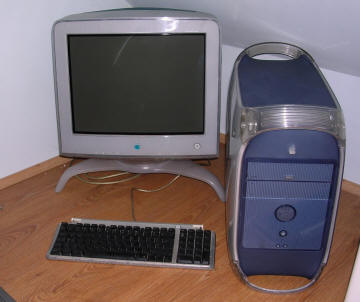Power Macintosh G4 450MHz (AGP)
A major update of similar computer, now included AGP graphics card, 100MHz system bus, and, in high-end models, DVD-ROM or DVD-RAM drives. Earlier ones had ZIP and CD-ROM drives. More, this model was ready for AirPort card, which allowed to use wireless networking. Some 450MHz units (pre February 2000) are underclocked 500MHz because Motorola couldn't deliver enough CPU chips for popular model.
| Model No: | M5183 | |
| Year: | 2000 | |
| Discontinued: | 2001 | |
| CPU: | PowerPC G4 450MHz | |
| RAM: | 256MB | |
| Max. RAM: | 2GB | |
| RAM Type: | 4 PC100 DIMMs | |
| Hard disk: | 10GB IDE, 3.5" SL (max. 128GB) | |
| Floppy drives: | None | |
| Other drives: | 32x CD-ROM | |
| Graphics: | AGP (ATI Rage 128/ 128 Pro) | |
| Sound: | 3.5mm Jack sound input / output (Stereo), one built-in speaker. | |
| Display: | Depends on graphics card installed (default: VGA or DVI-D) | |
| Dedicated OS: | Mac OS 8.6 (later 9) | |
| Maximum OS: | Mac OS X 10.4 | |
| Expansions: | USB, FireWire, Internal modem connector, AirPort internal expansion, 3 PCI slots, 1 AGP slot. | |
|
Additional peripherals in collection: |
||
| Connectors: | - 2 USB
connectors - 2 FireWire connectors - Ethernet connector - Audio in/out - Graphics card output.
|
|
This model was manufactured with many CPU and RAM variations, starting from 350MHz to 500MHz. There were 2 video cards for it, ATI Rage128 and Rage128 PRO.
My unit is in good condition, but its graphics card is not original. I have an original CRT which was used with it, 21" manufactured by Apple.
Here you'll find:
| Overclocking | Links |
Overclocking
As in all Power Macs, it requires some soldering, so I take no responsibility if it won't work. I have no experience in OCing these units, I don't know nor tried to discover safety boundaries of it, so do it on your own responsibility!.
According to what's in my CPU module and on the Internet, you should remove CPU card and flip it to see the PCB connector. It should look like this:
There are 3 regions: A is a CPU voltage selector, B is an actual overclocking setting, C is a L2 Cache signal selector.
Generally, the higher voltage is used, the higher frequency can be reached, but more (LOTS more) heat will be dissipated and the CPU may be destroyed.
Now, the explaination of the regions. Every combintation of 4 resistors form 4 bits of configuration. Let's begin with B - CPU Multiplier:
R7 - PLL_CFG[0]
R9 - PLL_CFG[1]
R11 - PLL_CFG[2]
R12 - PLL_CFG[3]
They're aligned in order: 0,1,2,3 and then (from datasheet of MPC7400 controller chip. Placing 1K resistor sets the bit to 0!):
- 0100 - 2x
- 0110 - 2.5x
- 1000 - 3x
- 1110 - 3.5x
- 1010 - 4x
- 0111 - 4.5x
- 1011 - 5x
- 1001 - 5.5x
- 1101 - 6x
- 0101 - 6.5x
- 0010 - 7x
- 0001 - 7.5x
- 1100 - 8x
- 0000 - 9x
- 0011 - Everytinhing's off.
Now the voltage bits (A):
R78 - VID0
R44 - VID1
R39 - VID2
R38 - VID3
R37 - VID4
Meaning (bridging pads = 0!) is described in this document. Default setting is 2.1V.
You can tune L2 voltage (2.5V by default), but it's a very risky procedure. R51 and R52 forms a voltage divider, so:
L2 Voltage = 1.260 x (R51+R52)/R51. //By default both are 124 Ohms.
133MHz Bus modding
As I heard, it doesn't work with most units. You can clock everything in this Mac to work with 133MHz system bus. 133MHz memory is required and most PCI cards may not work. More, these Macs use bus clock to drive almost everything, even to run system clock, so it will tick faster without other firmware mods (read here). To find things responsible for system bus, look under the mainboard - they're on its bottom:
R435 - FS0
R434 - FS1
R433 - FS2
R432 - SSON
According to SG500 datasheet (here), working with this at 133MHz IS an actually overclocking the IC itself.
Links:
- http://support.apple.com/kb/DL1126?viewlocale=en_US -
Direct Link - Firmware Update 4.2.8.





